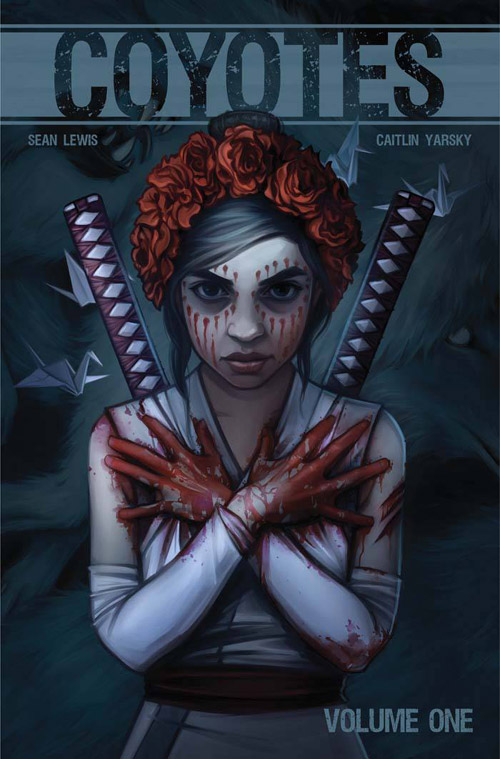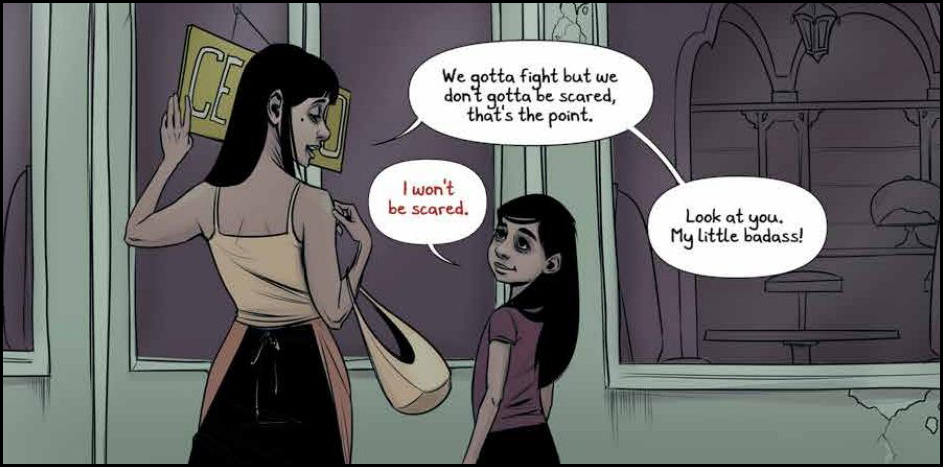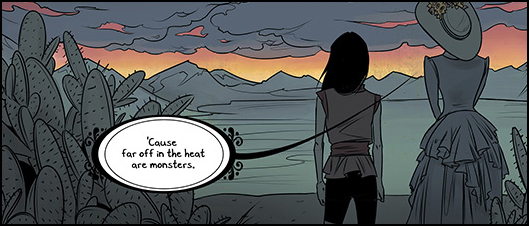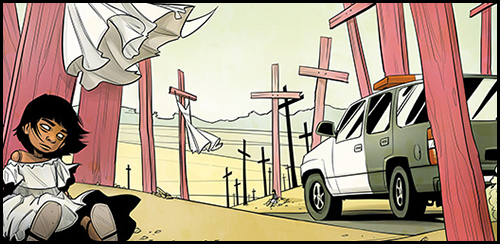Cunning Coyotes From Image Comics
Feb 09, 2018
 |
by Ashley Kronsberg
Women are going missing in the City of Lost Girls, a border town in the desert. Officer Frank Coffey is trying to get to the bottom of this when he meets Red, a thirteen year-old girl with a katana blade and a mission: murder the Werewolves stalking the border picking women off one by one. When it's discovered that the Wolves are the men of these villages, both Red and Officer Coffey are thrown together in a thriller of mythic proportions with the lives of their friends and loved ones in the balance.
Kill Bill meets The Howling in the Coyotes Volume 1 TP (JAN180663) by creators Sean Lewis and Caitlin Yarsky. Check out exclusive interview with Lewis and Yarsky below!
**********
Ashley Kronsberg: Coyotes Volume 1 is thought-provoking, well-balanced, and takes the idea of missing women and empowers others to fight back. What inspired this story? How did you decide to have the story take place along the border?
Sean Lewis: I’d heard an NPR documentary about a woman in Mexico that authorities were calling “The Blonde.” Basically, women were going missing along a bus route. The police weren’t able to find out why and the women in the area were terrified. Eventually, a woman in a blonde wig started riding these buses. She would wait until the very last stop, after everyone had gotten off the bus, and then she would approach the driver and execute him. Her logic, it’s assumed, was the drivers were either the people responsible for these disappearances or they knew who were.
I started thinking what the mythic version of this would look like? And Coyotes popped in my brain. What if the men who bring people across borders, often in predatory fashion, were ACTUALLY coyotes.
I like allegory because it allows people to get out of themselves for a moment. It allows an issue to exist without overshadowing the story. Half the fight in everything is getting people to engage with polarizing ideas. You say a story is set along the border and people shut down. You tell them it is about werewolves and suddenly those same people are like, “I might give it a try.”
In truth, the border is not something most Americans have any everyday interaction with. No relationship. But everyone has an opinion on it. I find it weird. I kind of look at it as nothing more than a dividing line: “what we can do for people, stops here.” That’s an interesting idea to examine, in my opinion.
It also allows me to write about a group of women wielding Katana blades. So, I get to have fun and explore larger ideas at the same time.
Ashley Kronsberg: Our story follows Red, a young girl who has joined a band of survivors who fight against the wolves who are taking and killing women in her community, a decision that came after she lost her sister, Maria, to the wolves. What is the importance of Red being the champion of the story as opposed to say, Maria or another one of the surviving women?
Sean Lewis: I’m kind of a sucker for coming of age stories. I find life so confusing a lot of the time. So much so, I still feel like a kid floundering around. So, I like characters in that part of their lives. Who are trying to figure it out, who can make mistakes but who also have the potential to become so much better than any of us… That is the beauty of a bildungsroman. It is full of potential. I think they work because they remind us that we still have that potential as well.

In this world of women there are many competing ideas. You have women like the Abuelas, who have been fighting the Wolves forever. They believe in balance. They aren’t militant but reactionary. If attacked they will attack back. They believe progress takes time. Then you have the Duchess and her followers. She is a generation younger than the Abuelas. Her group is an army. They are out on the offensive. They believe their freedom will come from attack. And then you have Red. The youngest person we see in this story. She is figuring out what she wants to be. Does she want to be a warrior? Does she believe the only way to safety is through violence and fear?
Red is the one character who is not formed in her ideas at the top of the story. She is being trained but does she agree with what she is taught? We are able to investigate our own feelings about gender and identity through her questions.
Ashley Kronsberg: Sean, what kind of research went into writing this story? How do you draft out your scripts to keep everything poignant and well-paced as the story progresses?
Sean Lewis: I mean, it’s a mash up of things I love with things that scare me. I love the B movies I grew up with on public television in NY: Death Wish, Near Dark, Assault on Precinct 13, the Warriors… I also love Kurosawa and hip hop and punk rock. Kathleen Hanna and French films like Baise-Moi and High Tension. I’m also scared of monsters. I’m scared of what it means to be a man sometimes.
The biggest research was the myth. I started reading about the history of Werewolves, men being tried in Europe for serial murders. It was insane.
Now, when I write the first draft I basically don’t edit anything in the beginning. I write a non- stop stream of conscious short story. This I call the GUTS draft. It lets everything jumbled in my head come out on the page.
Then, I throw it at Caitlin.
Well, I should say, Caitlin and I talk a lot before she sees scripts. She has such an amazing and singular style I stay away from “directing” her and I think more about inspiring her. I write up that long form short story, that gives you atmosphere, world, events as well as the internal and external lives of the characters. This is all the information Caitlin needs. Then I let her run like wild fire.
Ashley Kronsberg: Caitlin, your art is phenomenal and a brilliant compliment to the story being told. Every character is filled with life, and you bring a natural diversity to the cast in tones, body types, and facial expressions. How did your art style develop to what we see in the pages of Coyotes? Do you have any special techniques that you’ve developed to bring characters to life this way?
Caitlin Yarsky: Thanks that’s very kind! I don’t think I have one specific way of coming up with character designs. Sometimes they’re loosely based on faces I find while looking for inspiration; other times the models I have posing for reference give me ideas on the look of the character. But more than anything it’s the writing. Sean usually has characters with such distinct personalities that, even with only a few clues or ideas on their race or wardrobe, it’s easy to imagine how those characters might look.

Ashley Kronsberg: This series is incredibly well thought out and provides readers with a real and authentic feeling as they turn each page. From the blend of Spanish and English to the individualized speech bubbles and text colors, each character feels real. With a growing cast, one could worry this would become muted as each new character was introduced, but that’s not the case in Coyotes. How do you two maintain the individuality of each character?
Sean Lewis: Wow. That’s a really nice thing to say.
I think in writing all I can try and do is ensure that each character has their own goals and their own point of view. Point of View is big for me, I feel like it’s what makes us who we are, it’s the thing that’s so identifying about us. The way you see the world ends up ebing how you talk and how people talk about you. It defines your morality and your ethics and it’s what allows an audience to say: I understand that person.
So, I just ask them- what do you think about things? And they usually tell me.
I come from theater and in theater all you have is dialogue to express the singularity of each person. I work the same way in comics. The way a person talks gives you so much in regards to how they think. And how we thing IS what makes us different from one another.
So, I look a lot at their speech. What they say and how they articulate it… and if their goals and allegiances are clear in each line they speak.
Caitlin Yarsky: Sean has a way with character development and dialogue that distinguishes everyone really clearly. And since the story is already oozing with attitude, I have a great time visually on my end, giving them unique mannerisms and expressions. Duchess for example jumped to life immediately for me.
The juxtaposition of her conservative dress with her punk, badass leadership style led me to want her to have special, Victorian/old silent movie-like speech bubbles to compliment that. Or for Abuela, on the surface she has a quintessential granny look, but she’s fierce and mystical, so I started finding inspiration from images of the Mexican Revolution for her wardrobe in later scenes, and drew her with no whites in her eyes (which to me gives her more mystery and intrigue, like there is more to her than what you see).

Ashley Kronsberg: Speaking of a growing cast, with so many interesting characters I can’t help but ask - who is your favorite?
Sean Lewis: The most fun to write is Abuela. Call it the Betty White factor, but a tough, cursing, “couldn’t care less what anyone thinks” grandma is really freeing to put on paper.
Though, I always will have a soft spot for the Duchess. She’s the first character I saw in my mind when I thought of the story. There was something about this woman in the desert wearing Victorian clothing as a statement. Who refused to sweat in front of the people around her… She was fully formed from the get go. I knew what she wanted and what she believed in. Those are the type of characters you wait for.
Caitlin Yarsky: My favorite is definitely Abuela, at least from an art perspective. Older people can be really fun to draw, as they naturally have more character in their faces and you have more license to exaggerate. Plus she has this mysterious, ancient past mixed with a wild, tough attitude. I always get excited when Sean brings her into new scenes.




